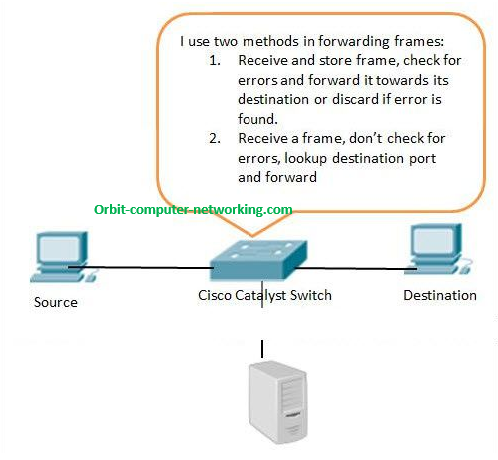Switch Packet Forwarding Methods.
Overview.
A network switch operates at the data link layer of the OSI model and is responsible for routing data packets between devices on a local area network (LAN). Switches use MAC addresses to determine where to forward packets, enabling efficient communication within the network. They come in various sizes and configurations, from small desktop switches for home use to large enterprise switches (cisco switches) capable of handling high volumes of network traffic.
Switches provide a crucial role in modern networking by facilitating reliable and high-speed data transfer between connected devices.
A switch uses a different method of forwarding frames in an Ethernet network. These methods are Store-and-Forward or Cut-through Switching.

Store-and-Forward Switching
In store-and-forward switching, when the switch receives the frame, it stores the received data in buffers until the complete frame has been received. While in the storage process, the switch checks and analyses the frame for information about its intended destination.
During this process, the switch checks the frame for errors using the Cyclic Redundancy Check (CRC) trailer portion of the Ethernet frame – a mathematical formula, based on the number of bits (1s) in the frame.
If the frame contains no error, the frame will be forwarded to the appropriate port towards its destination but when an error is detected the frame is dropped or discarded.
Cut-through Switching
In cut-through switching, the switch works on the frame as soon as it is received, even if the transmission is not complete. The switch records the destination MAC address to determine to which port to forward the data. The destination MAC address is located in the first 6 bytes of the frame following the foreword. The switch, in this case, does not perform any error checking on the frame.
Cut-through switching is faster than store-and-forward switching. However, because the switch does not check the frame for errors, it forwards corrupt frames throughout the network.
The corrupt frames consume bandwidth while they are being forwarded. The destination NIC- Network Interface Card- will eventually drop or discard the corrupt frames.
Cisco Catalyst switches use solely the store-and-forward method of forwarding frames
Most switches are configured to perform cut-through switching on a per-port basis until a user-defined error mark is reached and then they automatically change to store-and-forward. When the error rate falls below the threshold, the port automatically changes back to cut-through switching.
RELATED ARTICLES

